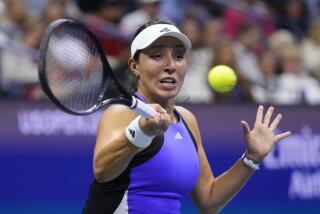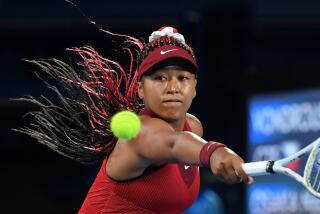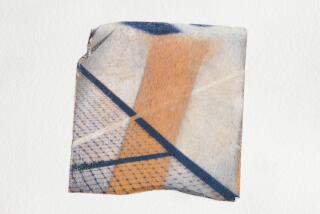Now She’s Doubling Her Fun
- Share via
NEW YORK — Every now and then the U.S. Open needs an old-timer to come along and take us all on a sentimental journey, like John McEnroe’s trip to the semifinals in 1990 or the time Jimmy Connors made it to the semis in ‘91, pumping his fists along the way.
This time, like everything else about this tournament, the best story to be found is on the women’s side.
It’s Martina Navratilova, 43 years old and still overwhelming opponents. She and doubles partner Arantxa Sanchez-Vicario knocked off Anna Kournikova and Jennifer Capriati Saturday night. Navratilova is as old as Kournikova and Capriati combined, and yet it was the kiddies who were sent to bed early, 7-5, 6-0.
About the only time Navratilova looked her age was in the fifth game of the second set. Navratilova lost the first two points on her serve. Then she started walking back to her chair, and reached into her bag. She had forgotten her glasses. She put them on, walked back to the baseline to a rousing ovation from the crowd, and shrugged her shoulders.
Then she and Sanchez-Vicario won the next four points to take the game.
How good is her story? Good enough to make a women’s doubles match, in a prime slot at Arthur Ashe Stadium, one of the best-attended night matches of the week.
The fans are loving this. They packed the grandstand court for her first match Thursday night and they waited out a 30-minute rainstorm to watch her Saturday night.
No one’s loving it more than Navratilova. She’s still competitive, still loves to serve and volley, still makes decisions and great shots at the net.
And she’s pumping her fists more often than Tiger Woods on Sunday.
“I’m having a blast and it’s good for my body and it’s fun to be out there and compete and hold your own,” Navratilova said. “And it’s sort of a throwback to how the game used to be played. I’m throwing [junk serves] at them and they don’t quite know what to do with it. I’m junking it now. I don’t have the power anymore so I junk and it works.”
It must have given her particular pleasure to finish off Kournikova, on the same day Kournikova’s singles draw ended with a loss to Justine Henin in the third round. The sport’s all-time winner took out the sport’s most profitable money-making machine. The game beat the name.
You can make a strong case that Kournikova is helping women’s tennis, bringing it more attention through her sex appeal. Surely the WTA doesn’t care why so many men are watching her matches, as long as they’re buying tickets and sitting in front of the TV sets.
But Kournikova isn’t advancing the sport, not the way Navratilova did by adding the element of physical fitness to the game and by challenging the sports world’s homophobia.
Kournikova made a very telling statement the other day when asked about the unique characteristics of the U.S. Open.
Comparing it to the quiet and stately Wimbledon, she said: “Here it’s more of the show, more of the excitement.
“You know, that’s what we play for. It’s about excitement, it’s about all this. It’s about being big.”
Maybe that’s why Kournikova’s ratio of magazine covers to tour victories is about 15:0.
Can you imagine Navratilova ever saying she played for the show and the excitement?
At her peak, she said, her motivation was: “Playing the best tennis that I can. See how good I can make it, see how good I could really be. I didn’t want to leave any stone unturned. I wanted to reach my potential.”
Navratilova finished up her full-time run on the singles circuit in 1994, after 167 tour victories and 19 Grand Slam titles.
She played mixed doubles at Wimbledon in 1996, but hasn’t played mixed doubles at the U.S. Open since 1995.
Her success in this women’s doubles tournament makes you think she could still win some matches on the singles tour, maybe even last a couple of rounds in the Grand Slams. But Navratilova isn’t about to get carried away.
“Playing singles is a commitment,” Navratilova said. “If I could serve like Alexandra Stevenson [who had just passed by in the hallway] I would probably still be playing and winning. I don’t have the size. For my game I need extreme quickness. I’m still faster than a lot of players, but not fast enough to be able to keep up. I would beat a few players.”
Not the likes of Serena Williams, though.
“She’d whip up on me,” Navratilova said. “They just hit the ball too hard. Again, I’m not fast enough. In the old days I’d be fine. They win so many points because they hit the ball hard and they get you on the defensive. But if you’re fast, then you can hit with them.”
So here is Navratilova, playing on the same grounds as players who were named after her, holding her own.
It could be the only thing that stops her is her own forgetfulness. Maybe she’ll show up at the wrong court and default. Maybe she’ll leave her glasses in the hotel room.
On this night, fortunately for her, they were only in the duffel bag.
“I have done that before, but I realized it before I played a point,” Navratilova said. “After the second point I’m thinking, I should have hit that volley. And I went to serve and I’m like, “Oh, no.’ And I’m like, ‘Should I pretend that I don’t know that I don’t have them and just keep playing? No, it’s too big a point.’ So I put them on.”
The woman in the glasses beat the woman on the magazine covers.
“Martina, you’re the best,” someone yelled from the upper deck.
The best player? Let’s not fool ourselves.
The best story? No doubt.
*
J.A. Adande can be reached at his e-mail address: [email protected].
More to Read
Go beyond the scoreboard
Get the latest on L.A.'s teams in the daily Sports Report newsletter.
You may occasionally receive promotional content from the Los Angeles Times.










